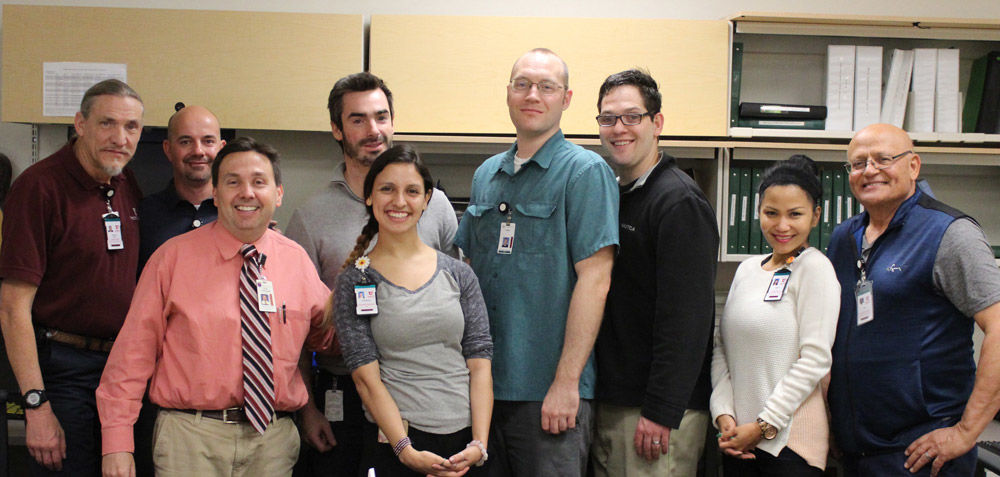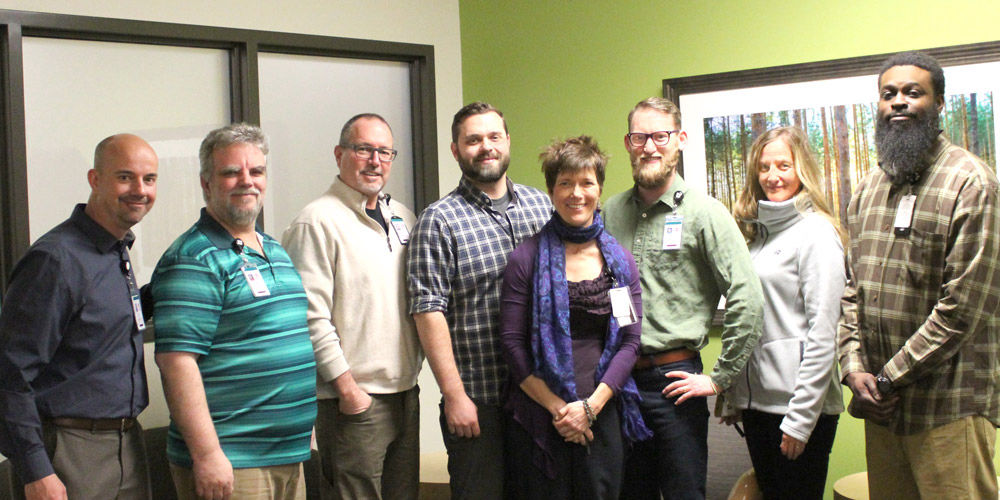ecently, I went through an interesting exercise in my personal life: my brother, who has been in heart failure for about 10 years, had open-heart surgery on the MICU at the University Hospital. In November of that year, he had an LVAD placed, and as a family member, I talked to nurses, dietary and financial representatives, the LVAD team, and the palliative care team. Then, as a nurse, I disseminated that information to my brother and his family.
A lot of times in these interactions, my stress level was high. But everyone in this organization really exceeded my expectations. That extends to the executives, too. The day my brother was getting extubated, he was in bed doing charades, pointing and trying to tell me something. Finally, I looked over and saw Dan Lundergan doing rounds with Tracey Nixon and Colleen Connelly. We have leaders in this organization who are present with our floor staff. That makes a difference—and it’s one that I see every day in my unit when Ross Van Vranken and Tom Woolf are there to answer questions and support my staff when things need to get done.
I’ve worked in mental health for 25 years, and I’ve identified the following lessons that are key for managing stress:
Authentic human connection is an essential leadership skill
What I love as a leader is the direct interactions I get to have with my staff members. I’ve learned a lot working with people who are compassionate and kind. All of us want to do what’s right, valuing every single individual we encounter, whether they’re patients or co-workers.

We go through many motions: keeping our offices open, answering emails, doing payroll, checking off the boxes. But how do we connect with others on an even deeper level? Direct human connection is essential. As you’re talking to someone, think about the interaction you’re having. Then, as you walk away from the interaction, challenge yourself to think, “Did I really see that person? Can I remember the color of their eyes? Did I see them as an individual and a person?” (Shout-out to Tom Woolf for this strategy.) As leaders, that’s what we should all be doing.
Call Code Lavender

How to perform your own Code Lavender
Tracy Farley’s instructions for a Code Lavender are simple:
- Sit up straight
- Feet flat on the floor
- Inhale for four seconds
- Exhale for six seconds
- Repeat as needed (6 cycles)
Exhibit that kind of compassion with patients, too
We have to see patients as they truly are. This is particularly difficult with patients who might have altered thoughts, who might be over-medicated or under-medicated, who might be confused, or who might have language barriers. Our presence with them—opening up and giving of ourselves while seeing them as a person—can make a big difference.
There’s a treatment modality we use at Huntsman Mental Health Institute called Acceptance and Commitment Therapy that helps us increase psychological flexibility. ACT assesses suffering with a formula: suffering = pain x resistance. If you resist stress, it actually can create more suffering. That’s where acceptance comes in. Whether you’re a patient or a staff member, you don’t want to always spend your time battling stress or anxiety. Recognize your problems, but don’t let them blind you to the present. It’s important to see the world as it is.
Identify (and overcome) stress
We all deal with stressful situations outside of work: I’m running late, my car won’t start, my kids are telling me they forgot their lunches. When I come in to work concerned about those problems, though, I cannot be an effective leader. My staff needs me to be present with them— that’s why we take the Code Lavender moment in the morning at the beginning of shift reports and doctor rounds.
Code Lavenders are brief exercises to help us be centered and present in the moment. No, we don’t gather to smell different essential oils. Instead, we just sit up straight, put our feet on the floor, inhale for four seconds, and exhale for six seconds. Code Lavenders allow us to slow down our breathing, which stimulates our parasympathetic nervous system and allows us to think about how we interact with our environment.
Throughout the rest of the day, I use other techniques to stay centered and grounded. Often, I just look out the window; at Huntsman Mental Health Institute, we have great views looking out on the valley. Sometimes, as I’m rounding, I’ll just stand there for a minute, noticing where the sun is and where the clouds are moving, so that when I enter the next unit to talk to the charge nurses and deal with today’s issues, my mind is clear.
We're all in this together
The University of Utah Health organization is vast. Everyone does their individual job, but we’re all in this together. The outpatient clinics throughout the valley see hundreds of people every day. My team and I do our work at Huntsman Mental Health Institute. Huntsman Cancer Institute and University of Orthopaedic Center provide world-class care. Meanwhile, University Hospital has kept my brother alive for the last 11 years.
He’s 50 years old, with five children and 13 grandchildren, and the care he’s received is astounding. Recently, he was sitting with the palliative care team, and they asked him, “What are your goals? What do you want to do with rest of your life?” He said, “I want to spend more time with my kids and grandkids.” Working together, this organization has made that possible for him. He’s not out of the woods yet, but because of the care he’s received, he can have those moments with his children.
Annotated transcript from Tracy Farley's presentation at the Nov. 30, 2017, Leader Development Insitute in Salt Lake City, Utah.
This article was originally published January 2018.
Tracy Farley
We’re all managing unprecedented stress and fear. What is “normal” right now? How do I cope? Social worker Jean Whitlock describes how our body protects us and offers some strategies to help.
Rising racist aggressions against the backdrop of an anxious and unnerving year can exacerbate the trauma racial groups and minorities experience. Megan Call of the Resiliency Center, social worker Jean Whitlock and EDI expert Mauricio Laguan explain racial trauma and how kindness, to ourselves and each other, is what this moment demands.
When life gets busy, it’s easy to forget what keeps us grounded and therefore more satisfied with life. Sydney Ryan reflects on the importance of making time for yourself and prioritizing what is important for you. She explains simple, deliberate actions that have made a difference in her work and her life.
